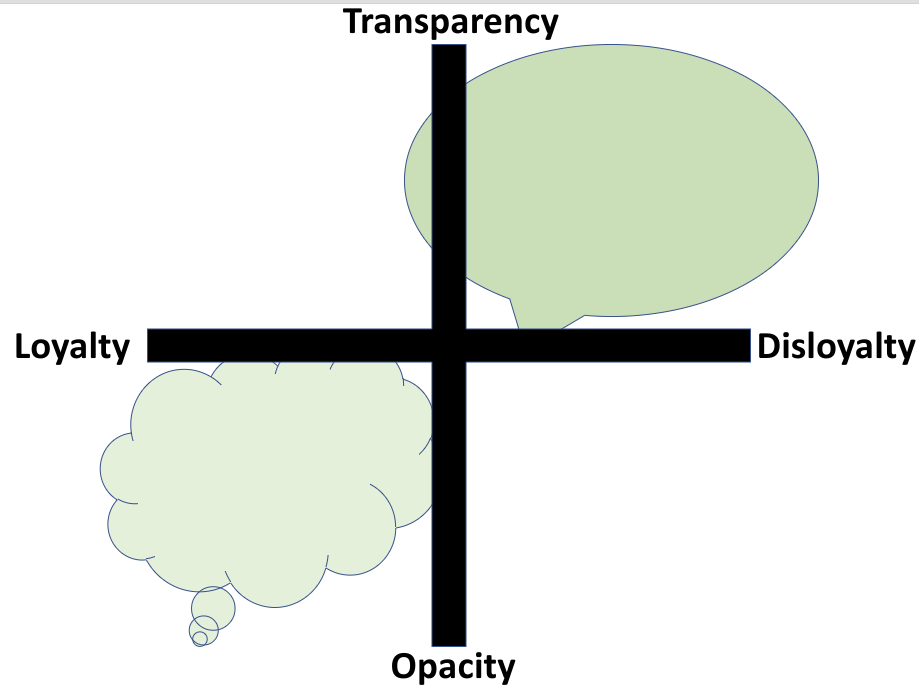 Not everybody sees the same things. Perhaps more importantly, not everybody shares the same things they see. This can cause challenges in businesses or in societal interactions. Understanding the underlying existence of the loyalty/transparency continuum is critical to parse out this conundrum.
Not everybody sees the same things. Perhaps more importantly, not everybody shares the same things they see. This can cause challenges in businesses or in societal interactions. Understanding the underlying existence of the loyalty/transparency continuum is critical to parse out this conundrum.
As you can see in the diagram, it contrasts the following elements:
- Loyalty versus disloyalty
- Transparency versus opacity

Whether one is talking about brand loyalty, or airing the family secrets, this continuum is sitting behind the scenes, influencing how situations are communicated.
Baby Boomers were raised by the Traditionalists generation, who valued *loyalty* highly. (Note: Referring to this generation as the "Greatest Generation" is faulty, because faux superlatives are dangerous.) This generation had many experiences that they wished to remain unmentioned, some up to and until their death. The Boomers' loyalty was modified yet again within Generation X and so on. Whether one is talking about brand loyalty, patriotic loyalty to one's country--for better or worse--, or airing the family laundry, this continuum is sitting behind the scenes, influencing how situations are communicated.
Millennials (and, perhaps, Generation Y, or Gen-Y) value *transparency* very highly, according to this 2017 Forbes magazine article. And while the article specifically relates to "spend" (ie, how money is spent, how much, and why), know that the transparency value has a way of flowing into other domains. Imagine how this plays out in employees' willingness to bare all their employment experiences on a website like Glassdoor.com, or their product issues in Google reviews or on Amazon.com.

As you can tell in this University of South Florida generational differences table above ⤴️, Generation X, or Gen-X is stuck in the middle. We see what a mess of things opacity can make, yet we may be tempted to avoid full transparency, because we fear life's miseries that may fly out of Pandora's box.
Further, note specifically in the table how loyalty morphs through the generations. Loyalty always exists, but to whom/what one is loyal changes widely among the generations. As the targets of loyalty morphs, perceptions of disloyalty may morph, as well. Here is a link to the PDF containing that table: htpps://www.usf.edu/hr-training/documents/lunch-bytes/generationaldifferenceschart.pdf&ved=2ahUKEwisuOGFyPj3AhUmoWoFHT_1BxkQFnoECCIQAQ&usg=AOvVaw3IStk9PabfT2Q2rtjSFqg
It is fascinating to read a mystery with a climax that hinges on an untold secret, such as, “This wedding cannot happen because the bride and groom are actually half-siblings.” How many of us, when we read that story, think something along the lines of, “When will someone just break down and tell the truth?" When push comes to shove, however, and someone is deciding what to share, there are so many factors to consider:
- How was the person raised to communicate: transparently or opaquely? Are they likely to flaut that training?
- How many people would be "hurt" if the truth were outed? How many may be hurt if it is not told?
- What is the truth, that many-faceted gem?
- Are there individuals who need to be protected?
- What could be lost if the full circumstances were made clear?
- This list is seemingly endless.
Many years ago, I attended a training about sexual harassment. In response to “has there ever been a time that" questions asked by the trainer, I shared a story about a series of events that occurred at a different company. The next time I met with my manager, s/he was aghast. “How could you share a story like that? Now, everyone who was in that training knows this about you. That's something I never would have done.” This reminded me that, even in supposedly safe spaces, people often revert to their personal loyalty/ transparency continuum--perhaps without even knowing they are doing so.
__________
How do you think this plays out in your business?
How do you think this unfolds in your nonprofit volunteerism?
How do you think this influences your relationships with family members and friends?
How does this impact what you share with others about your personal health?
